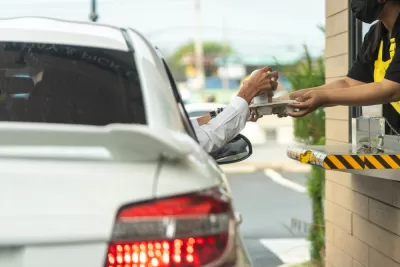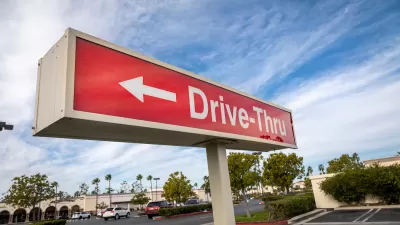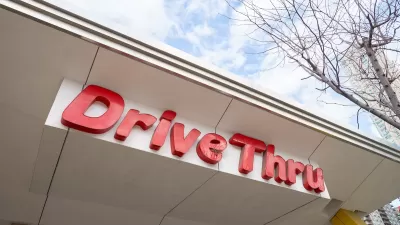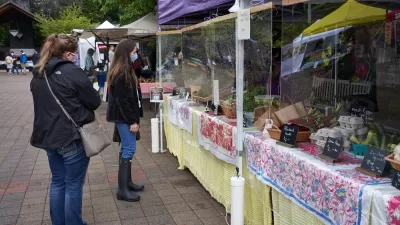Responding to pandemic-era shifts in customer demand, fast food and fast-casual chains are stripping away dining rooms, restrooms, and human cashiers in favor of drive-through and automated pickup options.

“Pushed by pandemic restrictions and pulled by the increasing ease of mobile transactions, customers have rushed into drive-thrus, delivery, and mobile ordering.” Consequently, writes Henry Grabar in Slate, most American fast food chains are opening “digital kitchens” with no indoor seating or in-person transactions. Emma Beckett, an editor at Restaurant Dive, says in addition to innovative new designs for new stores, “the arms race is on to remodel older stores with drive-thru lanes.”
Some chains are shifting to ‘ghost kitchens:’ “unmapped, closed-door facilities where food for delivery might be prepared for a dozen different brands at once.” In general, Americans are buying more prepared food than ever, with restaurant spending surpassing grocery spending for the first time in the 2010s.
Breakfast spending at coffee chains like Starbucks is the fastest-growing segment of the shift to eating out. “Despite its roots as an urban gathering place whose comfy chairs, Wi-Fi, and bathrooms invite customers to linger, on-and-off closures related to COVID have helped accelerate a business shift toward mobile, delivery, and drive-thru, which now make up almost three quarters of the brand’s U.S. revenue.”
“It’s not just mobile apps that are making these changes attractive, but an older technology that also promised both freedom and a kind of anti-social isolation: the automobile.” And with remote work making it possible to eat at home rather than in the office or on the go, it’s possible that, when it comes to where Americans want to spend their time, “nothing beats the kitchen table.”
FULL STORY: Take Your Fries and Leave

Planetizen Federal Action Tracker
A weekly monitor of how Trump’s orders and actions are impacting planners and planning in America.

Congressman Proposes Bill to Rename DC Metro “Trump Train”
The Make Autorail Great Again Act would withhold federal funding to the system until the Washington Metropolitan Area Transit Authority (WMATA), rebrands as the Washington Metropolitan Authority for Greater Access (WMAGA).

The Simple Legislative Tool Transforming Vacant Downtowns
In California, Michigan and Georgia, an easy win is bringing dollars — and delight — back to city centers.

The States Losing Rural Delivery Rooms at an Alarming Pace
In some states, as few as 9% of rural hospitals still deliver babies. As a result, rising pre-term births, no adequate pre-term care and "harrowing" close calls are a growing reality.

The Small South Asian Republic Going all in on EVs
Thanks to one simple policy change less than five years ago, 65% of new cars in this Himalayan country are now electric.

DC Backpedals on Bike Lane Protection, Swaps Barriers for Paint
Citing aesthetic concerns, the city is removing the concrete barriers and flexposts that once separated Arizona Avenue cyclists from motor vehicles.
Urban Design for Planners 1: Software Tools
This six-course series explores essential urban design concepts using open source software and equips planners with the tools they need to participate fully in the urban design process.
Planning for Universal Design
Learn the tools for implementing Universal Design in planning regulations.
Smith Gee Studio
City of Charlotte
City of Camden Redevelopment Agency
City of Astoria
Transportation Research & Education Center (TREC) at Portland State University
US High Speed Rail Association
City of Camden Redevelopment Agency
Municipality of Princeton (NJ)





























